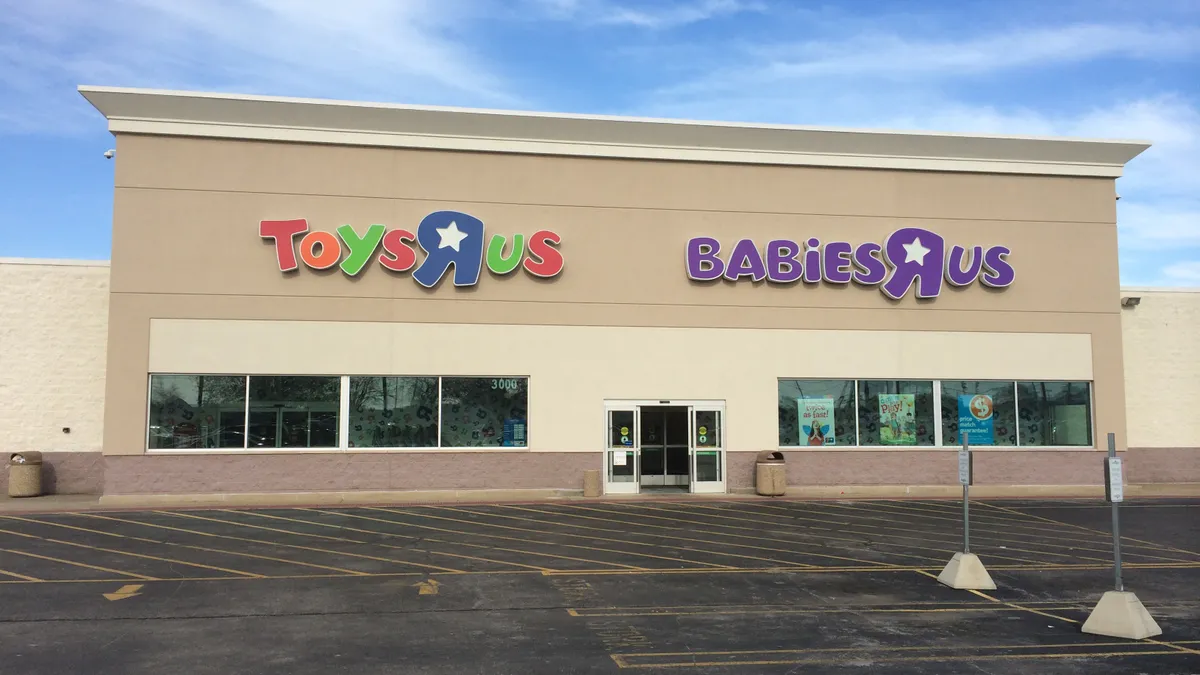Dive Brief:
- Children's apparel retailer The Children's Place is well-positioned to grab lost sales and market share from Toys R Us as it winds down its namesake and Babies R Us stores in the U.S., according to a report this week from Susan Anderson, senior research analyst with investment bank B. Riley FBR. The children's apparel retailer and wholesaler launched a "timely" new line of infant products, Bundles Baby Place, in February that Anderson estimates could add 2% to revenue in 2019 as Toys R Us winds down, she wrote.
- Up for grabs is the bankrupt retailer's $300 million children's apparel business, of which Carter's accounted for $120 million, according to Anderson's estimates. Carter's could make about half those sales from selling to other retailers and could capture additional share in baby apparel as other, weaker brands sold through Toys R Us and Babies R Us suffer from the liquidation, according to Anderson.
- Toy makers, of course, also stand to lose sales as the retailer liquidates its domestic stores, but Anderson wrote that her team thinks "wholesale partners are eager to work" with Hasbro and Mattel to get ahold of "the companies' iconic brands and market insights." This year Hasbro could recapture 35% of its lost $438 million sales with Toys R Us, and Mattel could recapture 25% of its $505 million in sales through the retailer, Anderson wrote.
Dive Insight:
Children's Place has been in the right place at the right time more than once in the past year. When rival Gymboree went bankrupt last year and closed hundreds of stores, Children's Place was only too happy to step in and fill the gap.
The retailer had stores open in more than half of the shopping centers where Gymboree has closed 326 of its stores, CEO Jane Elfers told analysts in March, according to a Seeking Alpha transcript of the call. "[P]ast experience indicates that we generated $150,000 in sales on average in the first 12 months in our stores that are co-located in malls where Gymboree closed," she said. "Gymboree's current round of liquidations represents approximately $30 million of opportunity for The Children's Place."
The difference between Gymboree's bankruptcy and Toys R Us', of course, is that Gymboree is still around to compete, albeit in a downsized form. But Toys R Us, with its Babies R Us stores, is set to leave the market entirely. (There are interested buyers in a large fraction of Toys R Us stores, but no such interest has materialized for Babies R Us so far, though it's intellectual property will likely get snatched up in the wind-down process.)
As for Hasbro and Mattel, they may have a $1.3 billion hole to fill should a deal for domestic stores fail to materialize. Toy makers all over are watching the collapse of Toys R Us with understandable wariness, as it not only leaves a gaping hole in the toy market but is also likely to increase the market power of Target, Walmart, Amazon and other massive retailers that don't rely on toy sales year round and are happy to position toys as loss leaders during the holiday shopping season to drive traffic.
The toy makers, however, operate in an era where they have perhaps more avenues than ever to reach, market and sell to customers. But even with online channels, they'll still need to find physical stores to replace Toys R Us — and they've already been working to do that. Hasbro CEO Brian Goldner said in April that the company over the past three years — during which Toys R Us' troubles were evident — has increased its retail distribution by more than 21,000 doors.













